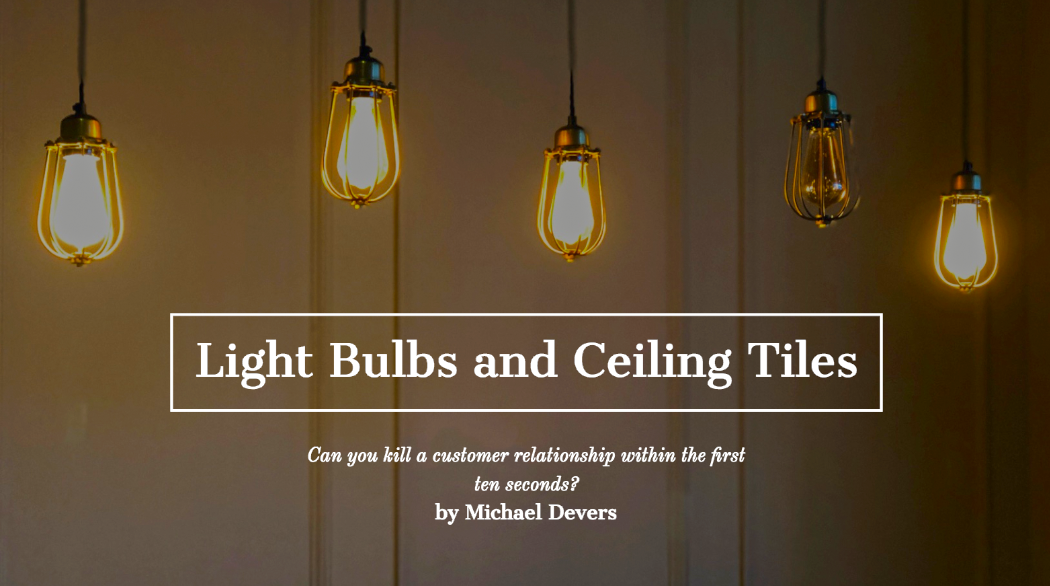I ruined Mother’s Day for my wife.
Her favorite special treat is breakfast for dinner. Every year for Mother’s Day, my wife looks forward to waffles, eggs, and all the bacon she can have for dinner with the family. As an added bonus, while everyone else is waiting in line for thirty minutes to an hour at places like the Olive Garden or Outback Steakhouse, we stroll right in and sit right down.
For many years, her restaurant of choice was the local IHOP. Until I ruined it. At least, that’s the way she sees it, and since it’s her tradition, her vote is the only one that counts. Secretly, I know IHOP ruined it. My only crime was noticing and bringing it to everyone’s attention. Allow me to paint you a picture.
Before you even walk in the door of the IHOP, something already looks off. The front doors only shut completely when deadbolted, apparently, as one of them is always slightly open. These front doors open into a vestibule, and the combination of the cracked-open door and the air-conditioning creates a rainforest effect with condensation running down the glass doors in sheets.
Once inside, the smell immediately grabs your attention. This IHOP-specific fragrance emanates from carpet that has collected a decade or more of food spills, humidity, and desperation. The eyes dart up to avoid staring at the carpet and that’s when you notice each ceiling tile is adorned with its own unique water stain. Adding to the ceiling artwork are the randomly placed shadows, due to the fact that one out of every three light bulbs is burned out and in need of replacing.
As you’re seated, the wear patterns on the seat fabric unveils the most popular tables. We usually requested the least popular tables where the fabric remained largely intact.
Lastly, as the server brings the menus, you stand a 50% chance of a preview of that night’s offerings from the kitchen, as wiping down the menus at this particular IHOP is a daily chore at best.
To my regret, I often pointed out every one of these issues, usually in excruciating detail, before pronouncing out loud, “This is going to be awful.” In retrospect, my behavior may not have been in the spirit of Mother’s Day.
First Impressions

How long does it take to make a first impression? Opinions vary depending upon the type of first impression we’re talking about, but the window is impossibly brief. When looking at another humanface, most experts agree the first impression is made within 500 milliseconds or less. That’s half of a second or less for you and me to size each other up and decide.
In his 2001 guide to building a better website, The Big Red Fez, marketing expert Seth Godin states that visitors decide to stay on a website or click on to another within 3 seconds. And that was 17 years ago when the Internet was in the Cretaceous period. Many of today’s estimates place the time at closer to 1.5 seconds.
When we examine a consumer to business interaction, the most common estimates state that the first impression is made within 7 seconds. Taken literally, this means the first impression settles in before human interaction with the customer takes place. They’ll decide based solely on how the business sets the stage. Anywhere first point of contact happens with your customer – the entrance, the lobby, the initial phone call, the front desk, the hostess stand, etc. – look at it again with the knowledge that you have 7 seconds (or less) to create the right impression.
The Sting
In the 1973 movie, The Sting, Paul Newman’s Henry Gondorff and Robert Redford’s Johnny Hooker, in order to exact revenge for a murdered colleague, work to con Robert Shaw’s character, the mobster Doyle Lonnegan.
The final stage of their long con takes place in a back-alley bookie joint owned by Gondorff, and where Hooker acts as Gondorff’s second-in-charge. All of which, of course, is a ruse to set up Lonnegan. The supposed bookie joint was an abandoned pool hall only days before Lonnegan walks in for the first time. In order for the con to work, Lonnegan must believe the entire enterprise to be a place that Gondorff has been operating for years. One false note would tip Lonnegan off, the con would fail, and Gondorff and Hooker’s lives would be in danger.
The duo and their team of associates go all out to ensure that every detail fit perfectly. Each chalk board, piece of artwork, stick of furniture, slip of paper, lamp, plant, and ashtray had to tell the story. Every individual who would be in the building when Lonnegan arrived was interviewed, assigned a character, and given wardrobe to match. All of this had to combine and create the right impression.
There’s a scene in the movie where Lonnegan first arrives to the elaborate production created solely for him. The camera shows him in close-up as he takes it all in, pauses, and allows the tiniest grin to slide across his face. The efforts Gondorff and Hooker went to great lengths to achieve paid off, Lonnegan bought it, and the con is on.
Get posts like this delivered straight to your inbox by clicking here and signing up for my free newsletter. It also enters you each month into a drawing to win a free book. The winner chooses from a list of titles.
Texas Exit Ramp
Approaching Austin on I-35 anywhere close to rush hour can prove problematic. On a poorly timed trip back home from Fort Worth, our family ran into this exact situation and, rather than fighting Austin rush hour, we opted for an early dinner. Relying on a random search on Yelp, we pulled up to what looked like an abandoned strip center to eat sushi in Belton, TX (population 20,873, salute).
 The abandoned strip center exterior sent our initial impressions down the negative track, but the moment we opened the door to Nami Japanese Steak and Sushi, that course changed. My son captured it the best. “It’s like something out of Harry Potter. Where you think you’re walking into a tent, but on the inside, it’s a mansion.” It was obvious in less than 7 seconds that the owners of Nami had invested significant resources in creating a unique atmosphere and a tremendous initial impression.
The abandoned strip center exterior sent our initial impressions down the negative track, but the moment we opened the door to Nami Japanese Steak and Sushi, that course changed. My son captured it the best. “It’s like something out of Harry Potter. Where you think you’re walking into a tent, but on the inside, it’s a mansion.” It was obvious in less than 7 seconds that the owners of Nami had invested significant resources in creating a unique atmosphere and a tremendous initial impression.
We were greeted by half of the staff as soon as we walked in, but the scene we saw captivated us more than any enthusiastic greeting could have. The elegant and well-planned interior contradicted the bland and generic exterior, reminding us more of upscale Vegas than Texas exit ramp. The color red ran throughout the design elements of the restaurant – walls, plates, upholstery, accents, and more. The ceiling tiles were this same red and suspended geometric shapes in white hung from them in sharp contrast. Also, none of the tiles were stained, all of the light bulbs were functional, and the menus were blessedly free of the previous patron’s meals. Everything was tidy, clean, and chic.
Even though it was an early dinner for us, we anxiously looked forward to our meals, largely due to the incredible job of setting the stage that Nami executed. Primed by the anticipation, we raved about the food between mouthfuls of it. I still rave about it. When I tell people they can find Texas’s best sushi in a little strip center in Belton, they always want to hear more.
Skid Marks and Death Threats
Setting the stage doesn’t automatically equate to scrubbing everything clean, as two store managers from the early days of Home Depot learned the hard way.
Long-time retailers Bernie Marcus and Arthur Blank held a specific vision in mind when they founded The Home Depot back in 1979. Though it seems par for the course today, their idea for a home improvement store that looked like a place where contractors could drive a forklift through the front door to buy a pallet of sheet rock was revolutionary at the time. For everyone else in retail in 1979, a grand opening equated to a brand new, pristine environment.
As Marcus and Blank share in their book, Built From Scratch, when the Home Depot was set for the grand opening of their first two stores ever, the managers of each store took it upon themselves to bring in overnight crews to scrub and wax the floors to a hospital shine.
When the first company executive, unable to sleep, showed up at 6am in advance of opening the doors, he was furious and leaped into action. In the time between discovering the clean floors and the grand opening, Home Depot employees in both stores hopped on forklifts and raced them around the stores, stomping on the brakes and scuffing up every aisle they could.
Marcus explains:
We wanted sawdust! We wanted skid marks on the floor! We didn’t want it to look like a hospital; we wanted the Home Depot to look like a warehouse.
We went crazy. Nuts! In a matter of hours, people would walk in and see this shiny floor. It was perhaps our worst nightmare – or so we thought at the time – because it was against everything that we wanted. The perception of the company would be changed. It didn’t look like a warehouse; it looked like a retail store. We even pushed back products that had been fronted on the shelves so that it looked like we had already been open. By the time we officially opened, we dirtied up the store enough that it looked like a warehouse again.
We told everyone, if anyone ever did that again, we would kill them. We wouldn’t fire them, because firing was not bad enough of a punishment; it had to be killing.
Marcus and Blank knew the importance of the first impression they wanted to create whenever a customer walked into a Home Depot for the first time. They intentionally designed the impression and went to great lengths – including death threats! – to ensure that vision would be executed every time a new store opened. To them, it was a matter of life and death.
The Triage of Business
All business resembles battlefield nursing. You constantly work in triage, deciding which limbs you can heal and which ones need to be hacked off because you just don’t have the time it would take to save them. When you’re up to your neck in mangled limbs, it’s difficult to take the time to administer a vaccination.
For most businesses, the good news is no one is going to die (with the exception of well-intentioned Home Depot managers) if we take time from the urgent to address the important. And for those businesses with customers (re: all of them), it doesn’t get more important than taking an intentional approach to designing the first 7 seconds of interaction. Poor businesses don’t do it all, average businesses do it as an afterthought, good businesses do it once and never touch it again. But great businesses know the importance of those 7 seconds and devote resources to the initial design as well as reviewing and updating it on a routine basis.
Try this exercise on your next day off: go to three different businesses you’ve never visited before. Walk in the door and immediately count to 10 as you take it all in. What does each business tell you about themselves with the first impression? What did you notice first? What impression do you walk out of the business with?
Now that you have some practice, walk into your own business and perform the same exercise. Can you see what your customers see?
Back to IHOP
On Friday night, our family returned to the New Braunfels IHOP. Apparently, I wasn’t the only one to notice the initial impression the restaurant presented. Since the last time we ate there, they’ve repaired the doors and remodeled the interior. The musty carpet was replaced with faux wood floors, the tables and seating refreshed, the light fixtures changed out, and every light bulb was lit.
Since IHOP put the effort into making a change, it was only right that I should as well, and announced to our group, “This is going to be amazing.” Truth be told, it wasn’t amazing, but it was pretty good. We’ll be back. This is something that a few years ago, I would have never thought I would say.
But just because you freshen up the form, it doesn’t mean you have to change out the fashion. The water-stained ceiling tiles remain intact at IHOP, artistic stalwarts and steadfast reminders of Mother’s Days past.
NOTES:
Here’s my list of 10 chain restaurants great at setting the stage for the experience within the first 60 seconds. This doesn’t necessarily mean I love the restaurants or the food. This list is strictly concerned with establishing what the establishment is all about as soon as you walk in the door.
In alphabetical order:
- Capital Grille
- Cheesecake Factory
- Cracker Barrell
- McDonald’s
- Olive Garden
- Outback Steakhouse
- F. Chang’s
- Red Lobster
- Rudy’s BBQ
- Texas Roadhouse
McDonald’s is the only fast food entrant on this list. Despite the fact that 99% of the planet knows what to expect from the Golden Arches, the other 1% could walk into one for the first time and know within 60 seconds what McDonald’s is all about.
This Week’s Recap:
Monday: What I Must Do. Hint: Work harder.
Tuesday: Cost Exceeds Price. When I only consider price and don’t include cost, I make bad decisions.
Wednesday: Grace. Defining grace proves problematic.
Thursday: Start In Your Trunk. Can you start a billion-dollar company from the trunk of your car? You wouldn’t be the first.
Friday: Celebrate Milestones: One Month. 33 days in a row and 2 shots of Jägermeister
Saturday: Celebrations. Where I borrow your celebration for the 100-day mark.
The Weekly Struggle:
“The previous month’s struggle” would be a better title this week.
You may have noticed a major redesign on my website today. Clair and I (mostly Clair) have been working on this for the past few weeks. We had grown frustrated at the lack of flexibility with the previous design, and when the company that created it sent an email stating they would no longer be supporting it, we looked for a new option. The problem with having tens of thousands of designs available for WordPress sites is that there are tens of thousands of designs available. After a long search, this current design includes 96% of what we had been looking for.
Today is only day two with the design on the live site, however, so a lot of the older posts require some mending and I’m still learning how to properly take advantage of the new design for posts like this. For now, please pardon our mess.
Best Thing I Saw This Week:
One of my favorite New Braunfels annual events, the Friends of the Library Book Sale, was held this weekend. To see a huge convention center floor filled with tables stacked high with books is a joy. My wife and I added to our dictionary collection and picked up some other fun books as well.
I also stumbled across a couple of record albums I needed to have. One featured excerpts of famous speeches and the other contains 26 Old Music Box melodies. I’m particularly looking forward to hearing “Old Oaken Bucket.” They saved it for the last track on side one, so you know it has to be good. Time to add a record player to my Christmas wish list.
Best Thing I Heard All Week:
It’s October: Play ball!
The MLB playoffs began this week, with Monday being a highly unusual Game 163 double-header. Two teams in two different divisions ended the season in a flat-footed tie for first place.
My Red Sox got started with October baseball on Friday and held on (barely) to beat the Yankees, 5-4. I’d like to say this article went to press before the conclusion of Game 2 of the series, but David Price once again spit the bit in a post-season start. Tonight was the shortest October start of his career and the Red Sox never recovered from the early runs he surrendered. We head to New York with the series tied at one apiece.
Quotes:
In difficult circumstances always act on first impressions.
~ Leo Tolstoy
Sometimes one creates a dynamic impression by saying something, and sometimes one creates as significant an impression by remaining silent.
~ Dalai Lama
End Credits:
My beautiful bride created this week’s title card once again. She’s bound to ask about being paid soon. The cartoon in the section on First Impresions originally appeared in New Yorker magazine, somewhere between 1955 & 1965. “The Set-Up” title card comes from the movie, The Sting. I took the pictures of both the Nami interior and the NB FOTL book sale.
# # # # # # # # #







Grace is the undeserved and unmerited favor of one in a position of power or control.
Amen, Jim!